 | |
| Publisher(s) |
|
|---|---|
| Designer(s) | Mark Turmell [2] |
| Platform(s) | Commodore 64 |
| Release | |
| Genre(s) | Racing [1] |
| Mode(s) | Single-player |
Fast Tracks is a racing game designed for the Commodore 64 by Mark Turmell and published by Activision in 1986. [2]
 | |
| Publisher(s) |
|
|---|---|
| Designer(s) | Mark Turmell [2] |
| Platform(s) | Commodore 64 |
| Release | |
| Genre(s) | Racing [1] |
| Mode(s) | Single-player |
Fast Tracks is a racing game designed for the Commodore 64 by Mark Turmell and published by Activision in 1986. [2]

The game involves running into other cars on the track. Each time a player bumps another car off the track, the car returns to the start of the lap, and two seconds are removed from the final time. If the player leaves the track they will have to restart the lap. [3]
A map editor is also available in the game, which can be saved onto the disc. [3] Seven circuits are built-in. [3]
Roy Wagner reviewed the game for Computer Gaming World , and wrote that "race tracks, that you create, can be sent to friends who don't even have the game. They can then try to beat your best times. This game offers a lot of variety and plays nicely. It comes in a close third to the Racing Destruction Set from EA and Pole Position". [4]

Pole Position is a racing arcade video game released by Namco in 1982. It was licensed to Atari, Inc. for US manufacture and distribution. Pole Position is considered one of the most important titles from the golden age of arcade video games. It was an evolution of Namco's earlier arcade racing electro-mechanical games, notably F-1 (1976), whose designer Sho Osugi worked on Pole Position.

F-Zero X is a 1998 futuristic racing video game for the Nintendo 64 console, developed and published by Nintendo. It is a sequel to the original F-Zero (1990), and is the first F-Zero installment with 3D graphics. The game has a steep learning curve and its gameplay experience is similar to that of the original. An Expansion Kit, including a track and vehicle editor, was released in Japan in 2000.

Adventure Construction Set (ACS) is a game creation system written by Stuart Smith that is used to construct tile-based graphical adventure games. ACS was published by Electronic Arts in 1984 for the Commodore 64, then for the Apple II, Amiga, and MS-DOS. Smith previously developed several commercial adventure games of a similar style, such as Ali Baba and the Forty Thieves (1981).

Stunt Car Racer is a racing video game developed by Geoff Crammond. It was published in 1989 by MicroProse, under their MicroStyle and MicroPlay labels in the United Kingdom and in the United States, respectively. The game pits two racers on an elevated track on which they race in a head-to-head competition, with ramps they must correctly drive off as the main obstacle.
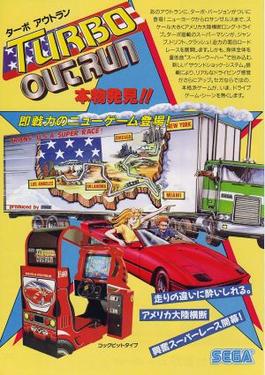
Turbo OutRun (ターボアウトラン) is a 1989 arcade racing game released by Sega. A follow-up to 1986's Out Run, it was released as a dedicated game, as well as an upgrade kit for the original Out Run board.
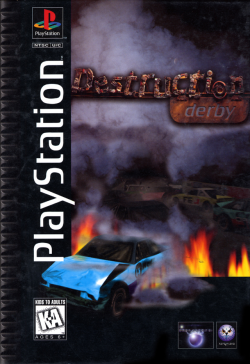
Destruction Derby is a 1995 vehicular combat racing video game developed by Reflections Interactive and published by Psygnosis for MS-DOS, PlayStation and Sega Saturn. Based on the sport of demolition derby, the game tasks the player with racing and destroying cars to score points. The developers implemented simulated physics to make the results of collisions easier to predict, and they kept the game's tracks small to increase the number of wrecks. Critics found Destruction Derby enjoyable and praised its graphics and car damage system, although the Saturn release received mixed reviews. The game started the Destruction Derby series, beginning with its 1996 sequel, Destruction Derby 2.

Portal is a text-driven adventure with a graphical interface published for the Amiga in 1986 by Activision. The writing is by American author Rob Swigart, and it was produced by Brad Fregger. Ports to the Commodore 64, Apple II, and IBM PC were later released. A version for the Atari ST was announced and developed, but not published. Until recently, it was thought that a Mac version left unpublished. The published Mac version was rediscovered in 2021 by a game collector.
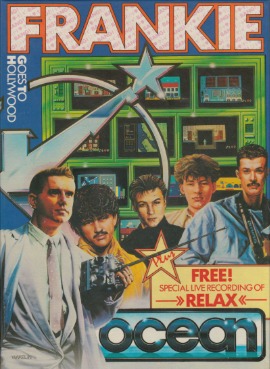
Frankie Goes to Hollywood is a computer game that was developed by Denton Designs and published by Ocean Software Ltd in 1985 for the Commodore 64, Amstrad CPC and ZX Spectrum home computers. The game is based on the music of UK band Frankie Goes to Hollywood.
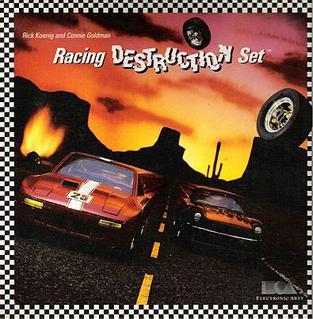
Racing Destruction Set is a racing video game published in 1985 for the Commodore 64 by Electronic Arts. It was advertised as being Commodore 128 compatible. A version for Atari 8-bit computers, programmed by Rebecca Heineman of Interplay, was released in 1986 in the United States, United Kingdom, and Germany. The game allows players to design and race on tracks with a variety of vehicles. It is part of the Construction Set series along with Pinball Construction Set, Music Construction Set, and Adventure Construction Set.
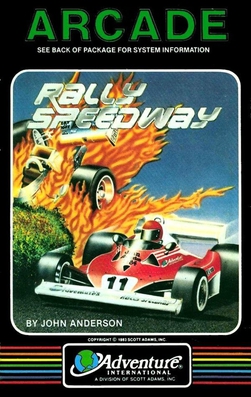
Rally Speedway is a top-down racing game developed by John Anderson for Atari 8-bit computers. It was published by Adventure International in 1983 as 16K ROM cartridge. A port to the Commodore 64 was published by Commodore in 1985. The game includes options for changing how vehicles handle, such as top speed, acceleration, and whether roads are wet, dry, or icy. There's also an integrated editor for creating and saving race tracks.

Indianapolis 500: The Simulation is a 1989 computer game for MS-DOS. It was hailed as the first step of differentiating racing games from the arcade realm and into racing simulation. It was developed by the Papyrus Design Group, and distributed by Electronic Arts. An Amiga port was released in 1990.

Super Monaco GP is a Formula One racing simulation video game released by Sega, originally as a Sega X Board arcade game in 1989, followed by ports for multiple video game consoles and home computers in the early 1990s. It is the sequel to the 1979 arcade game Monaco GP. The arcade game consists of one race, the Monaco Grand Prix, but later ports added more courses and game modes based on the 1989 Formula One World Championship.

Al Unser Jr.'s Turbo Racing is a racing video game for the Nintendo Entertainment System console released in 1990. It is an adaptation of the 1989 Japanese-market Famicom game World Grand Prix - Pole to Finish, with the most notable changes being the addition of Unser as an in-game coach, the number of laps, sound and interface design. Therefore, the game remains based on the Formula 1 World Championship, despite Unser having never competed in it. This game features a season mode and two time trial modes. In season mode the player uses either Al Unser Jr. or a make-their-own-driver.

Danny Sullivan's Indy Heat is a 1991 racing game developed and published in arcades by Leland Corporation. It stars American IndyCar driver Danny Sullivan, and features the tracks of the CART series of the early 1990s. Home versions of the game were released for the Nintendo Entertainment System, Amiga, Atari ST, and Commodore 64.

Garry Kitchen's GameMaker is an integrated development environment for the Commodore 64, Apple II, and IBM PC compatibles, created by Garry Kitchen and released by Activision in 1985. It is one of the earliest all-in-one game design products aimed at the general consumer, preceded by Broderbund's The Arcade Machine in 1982. Several sample files are included: a demo sequence featuring animated sprites and music, a recreation of Pitfall!, and a birthday greeting.

Shanghai is a computerized version of mahjong solitaire published by Activision in 1986 for the Amiga, Atari ST, Atari 8-bit computers, Commodore 64, MS-DOS, classic Mac OS, Apple IIGS, and Master System. Shanghai was originally programmed by Brodie Lockard. It was released as an arcade video game by Sunsoft in 1988.

Grand Prix Simulator is a racing game developed by The Oliver Twins and published by Codemasters for the ZX Spectrum, Amstrad CPC, Commodore 64, and Atari 8-bit computers. The ZX Spectrum conversion was done by Serge Dosang. The game was endorsed by Ayrton Senna's 1986 Formula One teammate Johnny Dumfries.

Lode Runner's Rescue is a 1985 action game developed by Joshua Scholar for the Commodore 64 and Atari 8-bit computers as a follow-up to Doug Smiths's Lode Runner. Lode Runner was published by Broderbund, but the sequel was published under the Synapse Software name, a company acquired by Broderbund in 1984. Lode Runner's Rescue uses isometric projection to give a 3D feel.

Pitstop is a 1983 racing video game developed and published by Epyx for the Atari 8-bit computers, ColecoVision, Coleco Adam, and Commodore 64. A sequel, Pitstop II, was released in 1984.
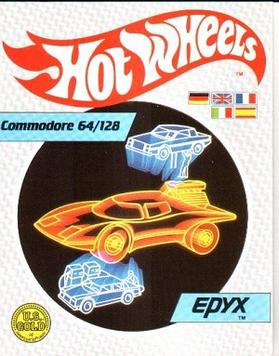
Hot Wheels is a racing video game developed by A. Eddy Goldfarb & Associates, and published by Epyx for the Commodore 64. The game was unveiled in June 1984, at Chicago's Summer Consumer Electronics Show, and was released later that year. Hot Wheels is the first video game to be based on the Hot Wheels toyline, and was marketed by Epyx as part of their Computer Activity Toys series, consisting of video games based on popular toylines.